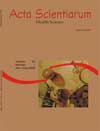<em>Staphylococcus aureus</em>: etiology and susceptibility profile to antimicrobial agents of skin and subcutaneous cell tissue abscesses from community infections
Abstract
An analysis of Staphylococcus aureus (Monera), an etiological agent of community infections, is provided. Staphylococcus aureus causes the formation of skin and subcutaneous cell tissue abscesses. Susceptibility profile to antimicrobials used in prophylaxis or therapy of these cutaneous infections will be given. One hundred and seven samples of secretions were collected from January 1996 through July 1997 at the emergency sector of University Hospital of the State University of Maringá, Maringá, state of Paraná, Brazil, from infected patients with skin and subcutaneous cell tissue abscesses. Microbiological evaluation was carried out according to Bayle and susceptibility to antimicrobial was evaluated in vitro through the technique of diffusion in agar according to Kirby. Sixteen antimicrobials used in prophylaxis or therapy of skin and subcutaneous cell tissue infections were evaluated. From the one hundred and seven clinical samples collected from patients complaining of infections with skin and subcutaneous cell tissue abscesses, 71 (66.35%) were positive to S.aureus and 36 (33,65%) were either positive for other microorganisms, or tested negative. In the evaluation of susceptibility to S.aureus a higher sensitivity to vancomycin (100%), teicoplanin (100%), amikacin (100%), cefoxitin (100%), cephalothin (98.53%), lincomycin (98.53%), gentamicin (98.53%), oxacillin (96,4%), norfloxacin (95.77%) and sulfazotrin (95.77%) was found when compared to penicillin G (08.45%), ampicillin (08.45%), kanamycin (81,69%), erythromycin (88.41%), tetracycline (90.14) and chloramphenicol (94,36%). Results show that S.aureus is the most frequently isolated microorganism from community infections with skin and subcutaneous tissue abscesses. The susceptibility profile evidences high resistance to penicillins, which restricts the use of these antimicrobials as an alternative in the prophylaxis or treatment of S.aureus community infections.Downloads
Download data is not yet available.
Published
2008-05-06
How to Cite
Zavadinack Netto, M., Herreiro, F., Bandeira, C. O. P., Ito, Y., Ciorlin, E., Saqueti, E. E., Ansilieiro, I. J., Gonsalves, L., & Siqueira, V. L. D. (2008). <em>Staphylococcus aureus</em>: etiology and susceptibility profile to antimicrobial agents of skin and subcutaneous cell tissue abscesses from community infections. Acta Scientiarum. Health Sciences, 23, 709-712. https://doi.org/10.4025/actascihealthsci.v23i0.2922
Issue
Section
Health Sciences
DECLARATION OF ORIGINALITY AND COPYRIGHTS
I Declare that current article is original and has not been submitted for publication, in part or in whole, to any other national or international journal.
The copyrights belong exclusively to the authors. Published content is licensed under Creative Commons Attribution 4.0 (CC BY 4.0) guidelines, which allows sharing (copy and distribution of the material in any medium or format) and adaptation (remix, transform, and build upon the material) for any purpose, even commercially, under the terms of attribution.
Read this link for further information on how to use CC BY 4.0 properly.























5.png)







